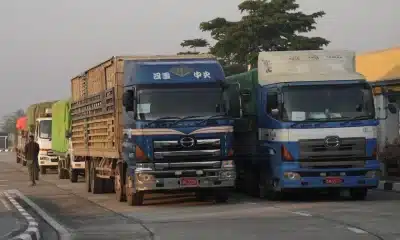World
As Thailand Gasps Through Another Haze Season, Researchers Hope A Fire-Charting App Can Help

Samoeng, Thailand — When the hazy season arrives, village chief Nanthawat Tiengtrongsakun and his tribesmen prepare the land for fires.
They chop bushes and trees on their little plots of land, then conduct controlled burns to clear their fields for planting – resulting in smoke clouds contributing to some of the world’s worst air. It’s a pleasant grey haze that reduces the mountains in this region of northern Thailand to a faint outline, makes the air feel solid, and makes breathing and swallowing difficult for some.
The Pakanyo, who have been practicing it for as long as they have lived in these hills around 90 minutes from Chiang Mai, a popular tourist destination, claim they are accused by city inhabitants of polluting the air and ruining forest land.
“We are the ethnic group that preserves the forest, but other people have the concern that we are destroying the forest,” stated Tiengtrongsakun. “My argument to them is that we’ve lived here for generations. If we are the ones who caused the devastation, the forest around us must be completely destroyed.”
The Pakanyo is just one example of several reasons demonstrating how deeply fire is embedded in local behaviors and why Thailand’s air pollution problem is so intractable.
During the haze season, which lasts from February to April, Chiang Mai is consistently ranked as one of the world’s most polluted cities. In March and April, the levels of fine particulate matter — dust, dirt, soot, and smoke that enter the lungs and even bloodstreams — are almost 20 times the World Health Organization’s recommended limit for exposure.
Thailand | AP News Image
As Thailand Gasps Through Another Haze Season, Researchers Hope A Fire-Charting App Can Help
The city is in the vanguard of Thailand’s fight against air pollution, not only because of its deadly air quality index readings but also because it has a strong civil society and a significant local government effort to address the issue. Prime Minister Srettha Thavisin has reinforced this endeavor, having visited Chiang Mai four times since entering office last summer. He has referred to Chiang Mai as a “model” that other Thai cities should follow, and he promised last autumn to push through clean air legislation to “ensure that access to clean air is a basic human right for all.”
Air pollution in northern Thailand has typically been blamed on farmers who grow maize and sell it to large agro-food corporations such as CP Foods for animal feed. There are alternative ways to deal with stubble, such as biochar, which includes burning in a low-oxygen atmosphere, resulting in lesser particle emissions. However, this needs a large amount of labor in highland locations. Even if most subsistence farmers had the necessary tools, tilling the stubble into the soil would be difficult due to the mountainous terrain.
CP announced in March that it has implemented a traceability system to prevent the purchase of maize grown on deforested or burned land. The same month, Srettha stated that he intends to ban the import of maize cultivated on land cleared by burning.
However, the problem extends beyond northern Thailand. According to researchers, corn planting has transferred primarily to neighboring Myanmar and Laos, where stubble burning is also practiced. Srettha has formed a working group with those countries to reduce the practice and urged Cambodia to join.
Chiang Mai University researchers investigated the origins of the city’s air pollution and found in April in the journal Atmospheric Environment that biomass burning accounted for more than 51% of the haze. According to the report, long-range pollution from other nations, most likely India, accounted for the second-largest percentage, almost 23%.
Fire is an important component of northern Thai culture, with local sayings predicting a period of development and rejuvenation. In everyday life, it is used to clean the forest floor to manage wildfires, to open space for an expensive fungus to develop that will bring in more money, and to remove the ground of loud leaves as part of hunting techniques.
Thailand | AP News Image
As Thailand Gasps Through Another Haze Season, Researchers Hope A Fire-Charting App Can Help
According to Olivier Evrard, a senior researcher at the French National Research Institute for Sustainable Development (IRD) headquartered in Thailand, fire is also frequently used as a protest method. A national issue emerged in 2018 when residents found that a judiciary branch had erected a dwelling and residential complex on protected forest property at the base of a sacred mountain outside Chiang Mai. They subsequently left the property due to the outrage, although fires are still set around the spot each year, most likely in protest.
There has been no shortage of policies aiming to control burning. Beginning in 2013, Thailand implemented a national zero-burning directive, with different provinces enforcing a blanket ban on burning at different times.
However, residents responded by burning before and after the zero-burn time, extending the haze season, according to Mary Mostafanezhad, a University of Hawaii professor researching air pollution in Chiang Mai. After determining that the zero-burning policy was ineffective, Chiang Mai province implemented a different policy: fires could be started as long as they were pre-approved.
The fires will be reported through FireD, an app Chiang Mai University professor Chakrit Chotamonsak created. The program utilizes weather and satellite data to anticipate if a fire on a specific day will increase pollution or if conditions will clear the smoke and pollutants.
The researchers estimate that up to half of the fires in the province are not registered, but they still see the app as a significant start. Even the decision to use FireD, a transliteration of “good fire” in Thai, in 2021 was significant, according to Chaya Vaddhanaphuti, an independent researcher who cooperated with the FireD team.
“This changes the perspective that fire was seen as a bad image, as savage,” he added, pointing out that many people in rural northern Thailand rely on fire.
Thailand | AP News Image
As Thailand Gasps Through Another Haze Season, Researchers Hope A Fire-Charting App Can Help
However, the villagers find it weird that they are being asked to fill out papers for permission to do something they already know how to do: set a planned burn in favorable weather to clear a section of land for the future year’s crops.
This year, Tiengtrongsakun, the Pakanyo chief in the village of Ban Mae Lan Kham, completed documentation for 100 households that needed to start a fire to clear fields. Only some people in the area speak Thai or know current government policy.
“If we hand them the document or registration form, they don’t know what to do with it,” he stated. “Often they just throw the papers away.”
According to researchers, officials must evaluate people’s living conditions and the specifics of where land is being burned and why. However, it is tough due to politics and economics. Many people who live in the hills around Chiang Mai belong to tribal tribes that the Thai government does not officially recognise. Others need help with obtaining a solid education and finding work. For now, burning remains the most efficient and cost-effective means for people to accomplish their tasks, whether farming, hunting, or clearing the forest floor.
“If burning is the easiest and most cost-efficient way to grow your crops, or to make a living, until that is not true, it’s going to continue to happen,” stated Mostafanezhad.
SOURCE – (AP)









































